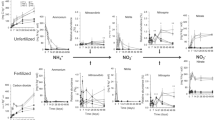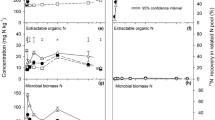Summary
Field studies to determine the effect of zero and shallow (10 cm) cultivation on microbial biomass were conducted on several Chernozemic soils in western Canada. Using the CHCl3 fumigation method, the distribution of microbial biomass N and the immobilization and subsequent release of added15N (15N-urea) from the microbial biomass were determined in the A horizon, at the 0 to 5 and 5 to 10 cm depth, during the growing season for spring wheat.
Temporal variation in microbial biomass N, associated with the development of the rhizosphere, was characterized by an increase between Feekes stage 1 and 5 or 10 and decrease at Feekes stage 11.4. Over the long term, the variation in biomass N between tillage systems corresponded with crop residue distribution. Immobilization of fertilizer N was related to the increase in biomass N from Feekes stage 1, which in turn, was associated with the incorporation of recent crop residues or levels of labile organic matter in the surface soil. The study demonstrated the relatively rapid remineralization of immobilized fertilizer N under field conditions and emphasized the role of the microbial biomass N as both a sink and source of mineral N.
Similar content being viewed by others
References
Carter M R and Rennie D A 1982 Changes in soil quality under zero tillage farming systems: distribution of microbial biomass and mineralizable C and N potentials. Can. J. Soil Sci. 62, 587–597.
Doran J W 1980 Soil microbial and biochemical changes associated with reduced tillage. Soil Sci. Soc. Am. J. 44, 765–771.
Jenkinson D S and Powlson D S 1976 The effects of biocidal treatments on metabolism in soil V. A method for measuring soil biomass. Soil Biol. Biochem. 8, 209–213.
Jenkinson D S and Ladd J N 1981. Microbial biomass in soil-measurement and turnover.In Soil Biochemistry Vol. 5. Ed. E A Paul and J N Ladd. Marcel Dekker, New York.
Ladd J N, Oades J M and Amato M 1981 Microbial biomass formed from14C,15N-labelled plant material decomposing in soils in the field. Soil Biol. Biochem. 13, 119–126.
Lindwall C W and Anderson D T 1981 Agronomic evaluation of minimum tillage systems for summer fallow in southern Alberta. Can. J. Plant. Sci. 61, 247–253.
Lynch J M and Panting L M 1980 Variation in the size of soil biomass. Soil Biol. Biochem. 12, 547–550.
Lynch J M and Panting L M 1982 Effects of season, cultivation and nitrogen fertilizer on the size of the soil microbial biomass. J. Sci. Food Agric. 33, 249–252.
Powlson D S and Jenkinson D S 1981 A comparison of the organic matter, biomass, adenosine triphosphate and mineralizable nitrogen contents of ploughed and directdrilled soils. J. Agric. Sci., Camb. 97, 713–321.
Author information
Authors and Affiliations
Rights and permissions
About this article
Cite this article
Carter, M.R., Rennie, D.A. Dynamics of soil microbial biomass N under zero and shallow tillage for spring wheat, using15N urea. Plant Soil 76, 157–164 (1984). https://doi.org/10.1007/BF02205576
Issue Date:
DOI: https://doi.org/10.1007/BF02205576




